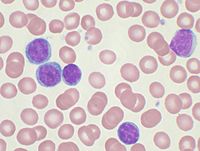
Photo from wikipedia
Richter syndrome (RS) refers to transformation of chronic lymphocytic leukemia (CLL) to an aggressive lymphoma, most commonly diffuse large B-cell lymphoma. RS is known to be associated with a number… Click to show full abstract
Richter syndrome (RS) refers to transformation of chronic lymphocytic leukemia (CLL) to an aggressive lymphoma, most commonly diffuse large B-cell lymphoma. RS is known to be associated with a number of genetic alterations such as TP53 and NOTCH1 mutations. However, it is unclear what immune microenvironment changes are associated with RS. In this study, we analyzed expression of immune checkpoint molecules and infiltration of immune cells in nodal samples, and peripheral blood T-cell diversity in 33 CLL and 37 RS patients. Compared to CLL, RS nodal tissue had higher PD-L1 expression in histiocytes and dendritic cells (median 16.6% vs. 2.8%, P < 0.01) and PD1 expression in neoplastic B cells (median 26.0% vs. 6.2%, P < 0.01), and higher infiltration of FOXP3-positive T cells (median 1.7% vs. 0.4%, P < 0.01) and CD163-positive macrophages (median 23.4% vs. 9.1%, P < 0.01). In addition, peripheral blood T-cell receptor clonality was significantly lower in RS vs. CLL patients (median [25th–75th], 0.107 [0.070–0.209] vs. 0.233 [0.111–0.406], P = 0.046), suggesting that T cells in RS patients were significantly more diverse than in CLL patients. Collectively these data suggest that CLL and RS have distinct immune signatures. Better understanding of the immune microenvironment is essential to improve immunotherapy efficacy in CLL and RS.
Journal Title: Blood Cancer Journal
Year Published: 2021
Link to full text (if available)
Share on Social Media: Sign Up to like & get
recommendations!